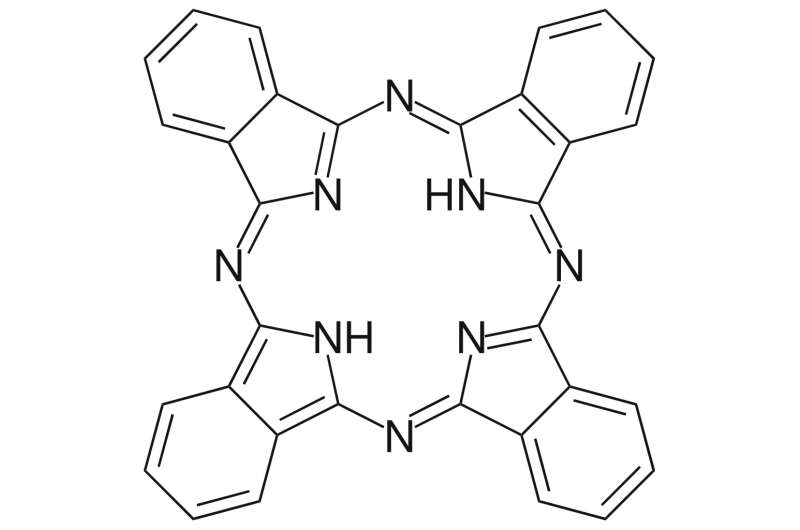Phthalocyanine. Credit: Wikipedia
A team of researchers from Austria, Germany, and the U.K. has succeeded in diffracting a beam of organic molecules. In their paper published in the journal Physical Review Letters, the researchers describe demonstrating Bragg diffraction of the molecules ciprofloxacin and phthalocyanine.
Over the long history of wave-particle research, scientists have found that light is both a wave and a particle. They have also shown that electrons have a similar wave-particle duality. Physicists theorize that wave-particle duality is a fundamental feature of the universe. This suggests that all matter should have wave-like phenomena, which means that it should be able to behave in ways that are similar to light and electrons. As one example, it should be possible to demonstrate interference and diffraction of matter, such as whole molecules. In this new effort, the researchers have done exactly that by demonstrating a type of diffraction pattern with molecules of ciprofloxacin (an antibiotic) and phthalocyanine (a kind of dye).
The work involved firing a laser beam at a sheet of glass upon which the ciprofloxacin and phthalocyanine molecules were applied, forcing them to fly off the glass at a very rapid speed. The molecules flew toward a barrier with a vertical slit that allowed only those molecules traveling in the desired direction to pass through. Those that passed through were met by another laser beam focused with a standing wave pattern. The high-intensity parts of the beam deflected the molecules in a way akin to passing through a gap, which led to the creation of a diffraction pattern. The molecules were then directed through another slit and immediately thereafter impacted a flat screen, where they adhered. And because the types of molecules the researchers chose for the experiment glow when exposed to UV or blue light, the researchers were able to see them. By running the experiment for a short period of time, the researchers were able to observe a pattern appear on the screen—evidence of a diffraction pattern.
The researchers were able to create different patterns by using different initial laser velocities and different incident angles. They note also that the patterns were weak, though still observable, and agreed with theory.
More information: Sophia Chen. Defracting a Beam of Organic Molecules, Physics (2020). DOI: 10.1103/Physics.13.s93
Journal information: Physical Review Letters
© 2020 Science X Network
























